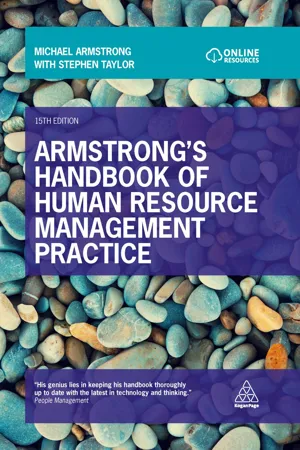
Armstrong's Handbook of Human Resource Management Practice
- English
- ePUB (mobile friendly)
- Available on iOS & Android
Armstrong's Handbook of Human Resource Management Practice
About this book
Armstrong's Handbook of Human Resource Management Practice is the bestselling and definitive resource for HRM students and professionals, which helps readers to understand and implement HR in relation to the needs of the business. This book covers in-depth all of the areas essential to the HR function such as employment law, employee relations, learning and development, performance management and reward, as well as the HR skills needed to ensure professional success, including leadership, managing conflict, interviewing and using statistics. Illustrated throughout in full colour and with a range of pedagogical features to consolidate learning (e.g. source review boxes, key learning points, summaries and case studies from international organizations such as IBM, HSBC and Johnson and Johnson), this fully updated 15th edition includes new chapters on the HRM role of line managers, evidence-based HRM, e-HRM and the gender pay gap, further case studies and updated content covering the latest research and developments. Armstrong's Handbook of Human Resource Management Practice is aligned with the Chartered Institute of Personnel and Development (CIPD) profession map and standards and is suited to both professionals and students of both undergraduate degrees and the CIPD's level 5 and 7 professional qualifications. Online supporting resources include comprehensive handbooks for lecturers and students, lecture slides, all figures and tables, toolkits, and a literature review, glossary and bibliography.
Frequently asked questions
- Essential is ideal for learners and professionals who enjoy exploring a wide range of subjects. Access the Essential Library with 800,000+ trusted titles and best-sellers across business, personal growth, and the humanities. Includes unlimited reading time and Standard Read Aloud voice.
- Complete: Perfect for advanced learners and researchers needing full, unrestricted access. Unlock 1.4M+ books across hundreds of subjects, including academic and specialized titles. The Complete Plan also includes advanced features like Premium Read Aloud and Research Assistant.
Please note we cannot support devices running on iOS 13 and Android 7 or earlier. Learn more about using the app.
Information
Fundamentals of human resource management
Introduction
HRM is about the management of people in order to achieve desired results.
Human resource management
Introduction
HRM: meaning and issues
HRM defined
HRM issues
Table of contents
- Cover
- Praise for Armstrong’s Handbook of Human Resource Management Practice
- Also available by Michael Armstrong
- Armstrong’s Handbook of Human Resource Management Practice
- Dedication
- Contents in brief
- Contents
- List of figures
- List of tables
- Preface
- PART I Fundamentals of human resource management
- PART II Delivering HRM
- PART III Human resource management processes
- PART IV Organization
- PART V Factors affecting the behaviour of people at work
- PART VI People resourcing
- PART VII Employment practices
- PART VIII Learning and development
- PART IX Performance management
- PART X Reward management
- PART XI Employment relations
- PART XII Employee wellbeing
- PART XIII HRM policies and practices and employment law
- PART XIV People management skills
- CIPD New Profession Map 2018
- Author index
- Subject index
- Copyright